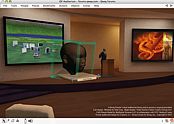| Home › Press Room › News Releases › |
| Intel News Release |
Qwaq, Intel Collaborate on Enhanced Virtual Workspace ProductINTEL DEVELOPER FORUM, San Francisco, Sept. 20, 2007 – Miramar, a 3-D information space technology originally developed by Intel Corporation’s research labs, will be brought to market by Qwaq Inc., the secure virtual workspace company. The agreement between the companies announced today at the Intel Developer Forum enables a new desktop visualization edition of Qwaq Forums that will integrate 2-D desktop applications and shared 3-D information workspaces for large numbers of users to easily visualize and manipulate enterprise information. Qwaq and Intel plan to work together to integrate Miramar technology into this new cross-platform edition of Qwaq Forums, which is expected be available next year. Justin Rattner, Intel Senior Fellow and director, Corporate Technology Group and Intel chief technology officer, demonstrated these new technologies today in his keynote on the future of virtual worlds. "Early adopters at Intel are currently using the Qwaq Forums to improve their teamwork. The combination of Miramar and Qwaq Forums will enable information, which is now only available to individual departments or divisions, to be easily accessed and shared across the enterprise, in dynamic unified views," said Rattner. "Intel envisions using the desktop visualization edition of Qwaq Forums to dramatically enhance the productivity of our global distributed workforce." Originally developed by Intel Architecture Labs, Miramar was designed to increase the productivity of distributed enterprises by enabling new information visualization capabilities across distributed teams. The Miramar technology leverages immersive 3-D environments and enables users to transition seamlessly among virtual environments and traditional 2-D desktop applications. Qwaq Forums, released earlier this year, significantly enhances the productivity of distributed teams by bringing critical resources together in a virtual place, as if they were in the same physical location, and providing them with all the tools and collaboration capabilities they need to work more effectively together. With Qwaq Forums, users can collectively establish workflow steps, create or review information in software applications, and evaluate designs in 2-D and 3-D, all while discussing topics using built-in text and voice chat. Qwaq Forums virtual workspaces are always available so users can return to a forum at any time to access and view changes that have occurred since they last visited the virtual space. "Virtual workspaces have already proven their value for enterprise collaboration," said Greg Nuyens, Qwaq chief executive officer. "The desktop visualization edition of Qwaq Forums provides distributed enterprises with a powerful new way to visualize and share information globally. Intel’s selection of Qwaq Forums to be the delivery platform for its Miramar technology is further recognition of the strength of our architecture and our approach to enterprise collaboration." About Qwaq, Inc. For more news coverage out of IDF, visit the complete press kit at www.intel.com/pressroom/idf. Intel, Intel Core, Centrino, and the Intel logo are trademarks of Intel Corporation in the United States and other countries. * Other names and brands may be claimed as the property of others. |
|
